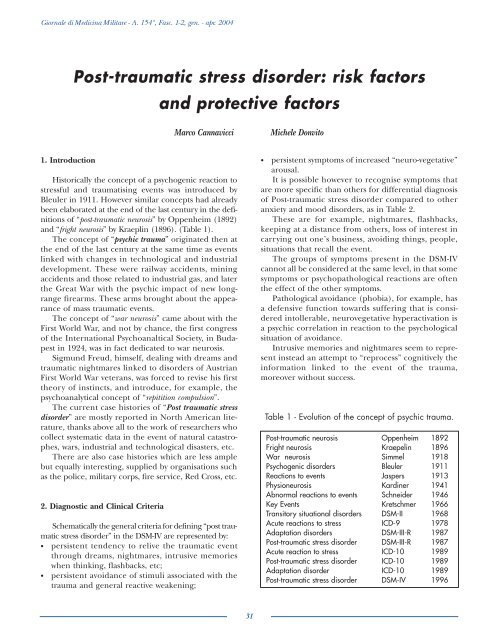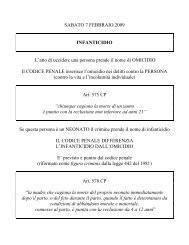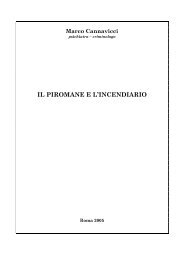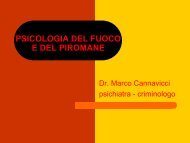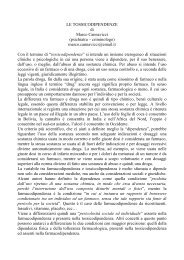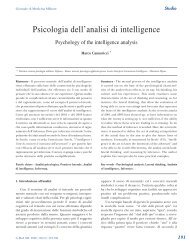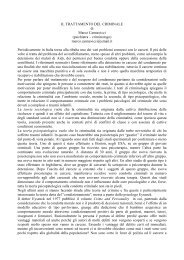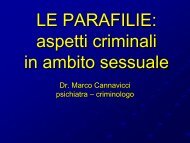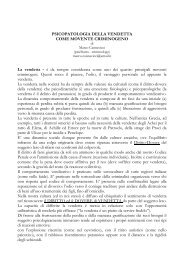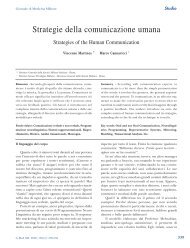Disturbo post-traumatico da stress: fattori di ... - Marco Cannavicci
Disturbo post-traumatico da stress: fattori di ... - Marco Cannavicci
Disturbo post-traumatico da stress: fattori di ... - Marco Cannavicci
You also want an ePaper? Increase the reach of your titles
YUMPU automatically turns print PDFs into web optimized ePapers that Google loves.
Giornale <strong>di</strong> Me<strong>di</strong>cina Militare - A. 154°, Fasc. 1-2, gen. - apr. 2004<br />
1. Introduction<br />
Post-traumatic <strong>stress</strong> <strong>di</strong>sorder: risk factors<br />
Historically the concept of a psychogenic reaction to<br />
<strong>stress</strong>ful and traumatising events was introduced by<br />
Bleuler in 1911. However similar concepts had already<br />
been elaborated at the end of the last century in the definitions<br />
of “<strong>post</strong>-traumatic neurosis” by Oppenheim (1892)<br />
and “fright neurosis” by Kraeplin (1896). (Table 1).<br />
The concept of “psychic trauma” originated then at<br />
the end of the last century at the same time as events<br />
linked with changes in technological and industrial<br />
development. These were railway accidents, mining<br />
accidents and those related to industrial gas, and later<br />
the Great War with the psychic impact of new longrange<br />
firearms. These arms brought about the appearance<br />
of mass traumatic events.<br />
The concept of “war neurosis” came about with the<br />
First World War, and not by chance, the first congress<br />
of the International Psychoanaltical Society, in Bu<strong>da</strong>pest<br />
in 1924, was in fact de<strong>di</strong>cated to war neurosis.<br />
Sigmund Freud, himself, dealing with dreams and<br />
traumatic nightmares linked to <strong>di</strong>sorders of Austrian<br />
First World War veterans, was forced to revise his first<br />
theory of instincts, and introduce, for example, the<br />
psychoanalytical concept of “repitition compulsion”.<br />
The current case histories of “Post traumatic <strong>stress</strong><br />
<strong>di</strong>sorder” are mostly reported in North American literature,<br />
thanks above all to the work of researchers who<br />
collect systematic <strong>da</strong>ta in the event of natural catastrophes,<br />
wars, industrial and technological <strong>di</strong>sasters, etc.<br />
There are also case histories which are less ample<br />
but equally interesting, supplied by organisations such<br />
as the police, military corps, fire service, Red Cross, etc.<br />
2. Diagnostic and Clinical Criteria<br />
Schematically the general criteria for defining “<strong>post</strong> traumatic<br />
<strong>stress</strong> <strong>di</strong>sorder” in the DSM-IV are represented by:<br />
• persistent tendency to relive the traumatic event<br />
through dreams, nightmares, intrusive memories<br />
when thinking, flashbacks, etc;<br />
• persistent avoi<strong>da</strong>nce of stimuli associated with the<br />
trauma and general reactive weakening;<br />
and protective factors<br />
<strong>Marco</strong> <strong>Cannavicci</strong> Michele Donvito<br />
31<br />
• persistent symptoms of increased “neuro-vegetative”<br />
arousal.<br />
It is possible however to recognise symptoms that<br />
are more specific than others for <strong>di</strong>fferential <strong>di</strong>agnosis<br />
of Post-traumatic <strong>stress</strong> <strong>di</strong>sorder compared to other<br />
anxiety and mood <strong>di</strong>sorders, as in Table 2.<br />
These are for example, nightmares, flashbacks,<br />
keeping at a <strong>di</strong>stance from others, loss of interest in<br />
carrying out one’s business, avoi<strong>di</strong>ng things, people,<br />
situations that recall the event.<br />
The groups of symptoms present in the DSM-IV<br />
cannot all be considered at the same level, in that some<br />
symptoms or psychopathological reactions are often<br />
the effect of the other symptoms.<br />
Pathological avoi<strong>da</strong>nce (phobia), for example, has<br />
a defensive function towards suffering that is considered<br />
intollerable, neurovegetative hyperactivation is<br />
a psychic correlation in reaction to the psychological<br />
situation of avoi<strong>da</strong>nce.<br />
Intrusive memories and nightmares seem to represent<br />
instead an attempt to “reprocess” cognitively the<br />
information linked to the event of the trauma,<br />
moreover without success.<br />
Table 1 - Evolution of the concept of psychic trauma.<br />
Post-traumatic neurosis Oppenheim 1892<br />
Fright neurosis Kraepelin 1896<br />
War neurosis Simmel 1918<br />
Psychogenic <strong>di</strong>sorders Bleuler 1911<br />
Reactions to events Jaspers 1913<br />
Physioneurosis Kar<strong>di</strong>ner 1941<br />
Abnormal reactions to events Schneider 1946<br />
Key Events Kretschmer 1966<br />
Transitory situational <strong>di</strong>sorders DSM-II 1968<br />
Acute reactions to <strong>stress</strong> ICD-9 1978<br />
A<strong>da</strong>ptation <strong>di</strong>sorders DSM-III-R 1987<br />
Post-traumatic <strong>stress</strong> <strong>di</strong>sorder DSM-III-R 1987<br />
Acute reaction to <strong>stress</strong> ICD-10 1989<br />
Post-traumatic <strong>stress</strong> <strong>di</strong>sorder ICD-10 1989<br />
A<strong>da</strong>ptation <strong>di</strong>sorder ICD-10 1989<br />
Post-traumatic <strong>stress</strong> <strong>di</strong>sorder DSM-IV 1996


